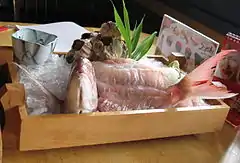Ikizukuri
Ikizukuri (生き作り), also known as ikezukuri (活け造り), (roughly translated as "prepared alive"[1]) is the preparing of sashimi (raw fish) from live seafood. In this Japanese culinary technique, the most popular sea animal used is fish, but octopus, shrimp, and lobster may also be used.[2]

The practice is controversial owing to concerns about the animal's suffering, as it is still alive when served.
Preparation and serving
The restaurant may have one or several tanks of live sea animals for a customer to choose from. There are different styles in which a chef may serve the dish but the most common way is to serve it on a plate with the filleted meat assembled on top of the body.
Ikizukuri fish may be prepared with only three knife cuts by the chef.[1] They are usually presented with the head still whole so that customers are able to see the continuing gill movements.[3]
Animal welfare concerns
Ikizukuri is outlawed in Australia and Germany.[4]
A petition was posted on Change.org addressed to Kenichirō Sasae, the Japanese Ambassador to the U.S., asking Japanese authorities to end the "live sushi” gastronomic custom.[3] The petition closed with 67,347 signatures.
See also
- Eating live seafood
- Pain in fish
- Pain in crustaceans
- Odorigui, the consumption of live seafood while it is still moving
- Ying Yang fish
References
- Demetriou, D. (March 23, 2008). "Japan's ikizukuri fish 'beats with freshness'". The Telegraph. Retrieved March 29, 2016.
- Nelson, S.C. (August 6, 2012). "Live lobster writhes on a dinner plate: Controversial Ikizukuri is freshest food available". Huffington Post UK. Retrieved March 29, 2016.
- Solar, I.I. (June 21, 2014). "Ikizukuri — For some, seafood that is 'too fresh' to eat". Digital Journal. Retrieved March 29, 2016.
- Moran, M. (June 16, 2007). "Microtrends: Ikizukuri". The Times. Retrieved March 29, 2016.